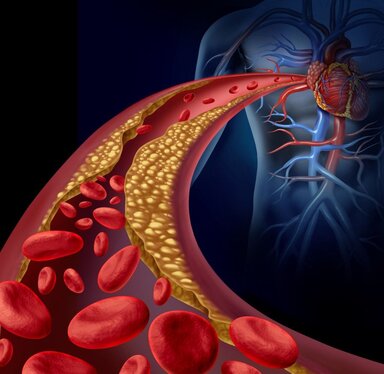 Dyslipidaemia refers to abnormal levels of blood fats or ‘lipoproteins’. Lipoproteins are the transporters that move fat around our bodies. The most common dyslipidaemias are high blood cholesterol and triglyceride levels known as hyperlipidaemia, high levels of low-density lipoprotein cholesterol (LDL-c, the ‘bad’ cholesterol) and low levels of high-density lipoprotein cholesterol (HDL-c, the ‘good’ cholesterol). How is it diagnosed? A blood test called a lipid profile is used to diagnose the condition, and management of dyslipidaemia is important for people with, or at risk of, cardiovascular disease because we know that a poor lipid profile is a significant risk factor for blood vessel damage. The risk of heart problems also increases with high triglyceride or LDL-c levels, or with low HDL-c levels. How does exercise help? Management of dyslipidaemia aims to reduce the risk of cardiovascular ‘events’ such as heart attacks that may occur within the next 5-10 years — this is called the absolute cardiovascular risk. Any lowering of LDL-c and triglycerides, or raising of HDL-c, is likely to reduce this risk. Improving our lifestyle by improving our diet, increasing our exercise to reduce our weight, especially body fat, is a key management strategy for decreasing cardiovascular risk. Physical fitness and regular exercise have both been shown to considerably reduce the absolute cardiovascular risk and death rate. Studies have shown that regular aerobic exercise can:
What types and intensities of exercise are recommended? People with dyslipidaemia should undertake aerobic exercise for at least 30 minutes on most, if not all, days of the week to improve their lipid profiles and reduce their cardiovascular risk. This amount can be accumulated in shorter bouts of 10 minutes duration and can be built up over time. We suggest aerobic exercise that uses large muscle groups such as brisk walking, jogging, cycling, swimming, dancing, skiing, playing ball games or other sporting activities. Research has also found vigorous aerobic exercise to be beneficial and improves HDL-c more than less-intense exercise. Vigorous aerobic exercise is described as a ‘very hard’ effort, and at this level you would not be able to hold a conversation whilst exercising as you would not have the breath to do so. In addition to aerobic training, progressive high-intensity resistance training (i.e. weight training) has also shown to improve HDL-c. For this the goal is to undertake 2–3 sets of 8–10 different exercises, at a load that can be performed for 8–15 repetitions of each exercise, at least twice a week. Don’t forget your warm up before both your aerobic and strength training exercises. Precautions People with known or suspected cardiovascular disease, metabolic syndrome or diabetes; people with a family history of heart attacks; people with high blood pressure; smokers; men aged over 45 years or women aged over 55 years; and people who have not been doing regular exercise should consult their doctor or Exercise Physiologist before commencing an exercise program. Lisa Parkinson Accredited Exercise Physiologist
0 Comments
|
AuthorSLisa Parkinson Archives
July 2024
Categories
All
|

 RSS Feed
RSS Feed